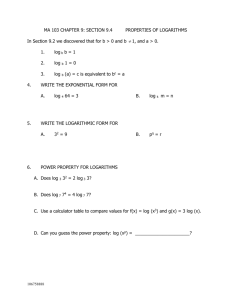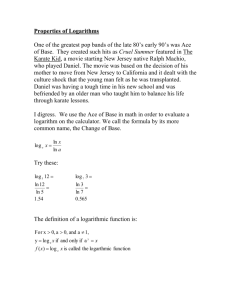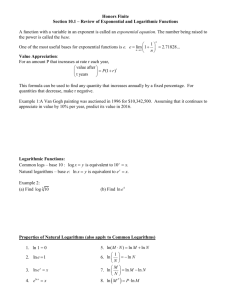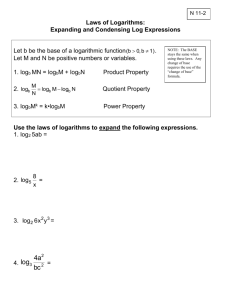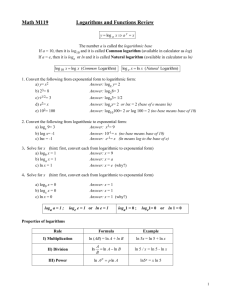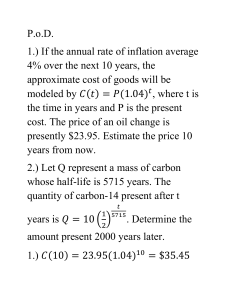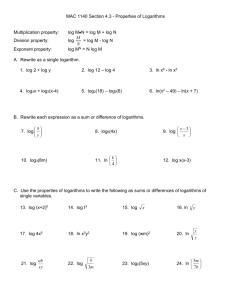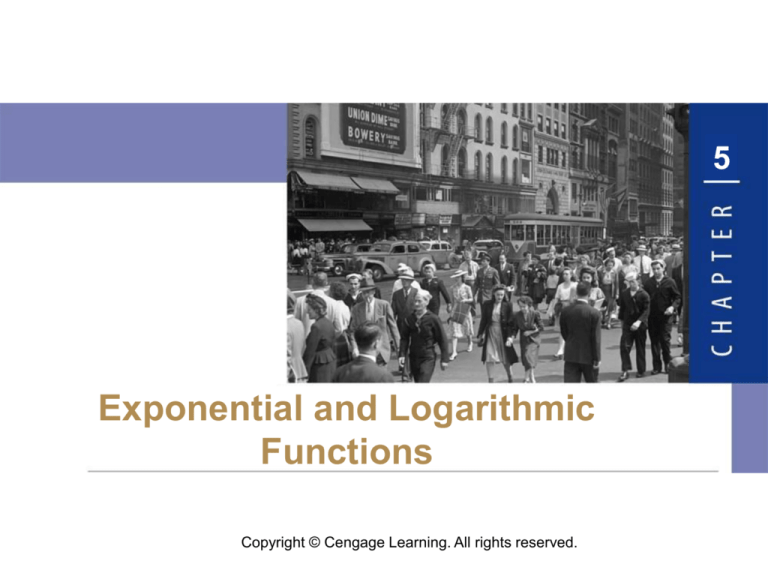
5
Exponential and Logarithmic
Functions
Copyright © Cengage Learning. All rights reserved.
4.4
Laws of Logarithms
Copyright © Cengage Learning. All rights reserved.
Objectives
► Laws of Logarithms
► Expanding and Combining Logarithmic
Expressions
► Change of Base Formula
3
Laws of Logarithms
4
Laws of Logarithms
Since logarithms are exponents, the Laws of Exponents
give rise to the Laws of Logarithms.
5
Example 1 – Using the Laws of Logarithms to Evaluate Expressions
Evaluate each expression.
(a) log4 2 + log4 32
(b) log2 80 – log2 5
(c)
log 8
Solution:
(a) log4 2 + log4 32 = log4(2 32)
= log4 64 = 3
Law 1
Because 64 = 43
6
Example 1 – Solution
(b) log2 80 – log2 5 = log2
= log2 16 = 4
(c)
log 8 = log 8–1/3
cont’d
Law 2
Because 16 = 24
Law 3
= log
Property of negative exponents
–0.301
Calculator
7
Expanding and Combining
Logarithmic Expressions
8
Expanding and Combining Logarithmic Expressions
The Laws of Logarithms allow us to write the logarithm of a
product or a quotient as the sum or difference of
logarithms.
This process, called expanding a logarithmic expression, is
illustrated in the next example.
9
Example 2 – Expanding Logarithmic Expressions
Use the Laws of Logarithms to expand each expression.
(a) log2(6x)
(b) log5(x3y6)
(c) ln
Solution:
(a) log2(6x) = log2 6 + log2 x
Law 1
(b) log5(x3y6) = log5 x3 + log5 y6
Law 1
= 3 log5 x + 6 log5 y
Law 3
10
Example 2 – Solution
(c)
cont’d
= ln(ab) –
Law 2
= ln a + ln b – ln c1/3
Law 1
= ln a + ln b – ln c
Law 3
11
Expanding and Combining Logarithmic Expressions
The Laws of Logarithms also allow us to reverse the
process of expanding that was done in Example 2.
That is, we can write sums and differences of logarithms as
a single logarithm.
This process, called combining logarithmic expressions, is
illustrated in the next example.
12
Example 3 – Combining Logarithmic Expressions
Combine 3 log x + log (x + 1) into a single logarithm.
Solution:
3log x + log(x + 1) = log x3 + log(x + 1)1/2
= log(x3(x + 1)1/2)
Law 3
Law 1
13
Expanding and Combining Logarithmic Expressions
Logarithmic functions are used to model a variety of
situations involving human behavior.
One such behavior is how quickly we forget things we have
learned.
For example, if you learn algebra at a certain performance
level (say, 90% on a test) and then don’t use algebra for a
while, how much will you retain after a week, a month, or a
year?
Hermann Ebbinghaus (1850–1909) studied this
phenomenon and formulated the law described in the next
example.
14
Example 5 – The Law of Forgetting
If a task is learned at a performance level P0, then after a
time interval t the performance level P satisfies
log P = log P0 – c log(t + 1)
where c is a constant that depends on the type of task and
t is measured in months.
(a) Solve for P.
(b) If your score on a history test is 90, what score would
you expect to get on a similar test after two months?
After a year? (Assume that c = 0.2.)
15
Example 5 – Solution
(a) We first combine the right-hand side.
log P = log P0 – c log(t + 1)
Given equation
log P = log P0 – log(t + 1)c
Law 3
log P =
Law 2
P=
Because log is
one-to-one
16
Example 5 – Solution
cont’d
(b) Here P0 = 90, c = 0.2, and t is measured in months.
In two months:
t=2
and
In one year:
t = 12
and
Your expected scores after two months and one year are
72 and 54, respectively.
17
Change of Base Formula
18
Change of Base Formula
For some purposes we find it useful to change from
logarithms in one base to logarithms in another base.
Suppose we are given logax and want to find logbx.
Let
y = logb x
19
Change of Base Formula
We write this in exponential form and take the logarithm,
with base a, of each side.
by = x
Exponential form
loga (by) = loga x
Take loga of each side
y loga b = loga x
Law 3
Divide by logab
20
Change of Base Formula
This proves the following formula.
In particular, if we put x = a, then loga a = 1, and this
formula becomes
21
Example 6 – Evaluating Logarithms with the Change of Base Formula
Use the Change of Base Formula and common or natural
logarithms to evaluate each logarithm, correct to five
decimal places.
(a) log8 5
(b) log9 20
Solution:
(a) We use the Change of Base Formula with b = 8 and
a = 10:
log8 5 =
0.77398
22
Example 6 – Solution
cont’d
(b) We use the Change of Base Formula with b = 9 and
a = e:
log9 20 =
1.36342
23

